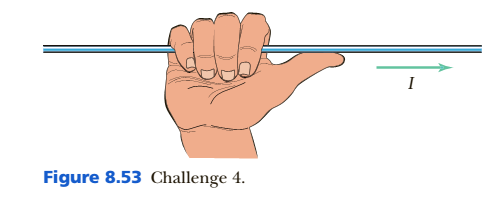
Concept explainers
The right-hand rule is a way to determine the direction of the magnetic field produced by moving charges. Imagine wrapping your right hand around the path of the charges so that the positive charges (or the current) flow from the little finger side of your fist to the thumb side (Figure 8.53). Then your fingers circle the path in the same direction as the magnetic field lines. Use this rule to verify the directions of the magnetic fields shown in Figures 8.8 and 8.10. How would you use the rule to find the direction of the magnetic field lines around a moving negative charge?

Trending nowThis is a popular solution!

Chapter 8 Solutions
Inquiry into Physics
Additional Science Textbook Solutions
Cosmic Perspective Fundamentals
Fundamentals of Physics Extended
Microbiology Fundamentals: A Clinical Approach
Brock Biology of Microorganisms (15th Edition)
Organic Chemistry (8th Edition)
Introductory Chemistry (6th Edition)
- Current Attempt in Progress In the figure what is the net electric potential at point P due to the four particles if V = 0 at infinity, q = 2.12 fC, and d = 1.75 cm? d Number MI Units +qarrow_forwardA 0.500 kg sphere moving with a velocity given by (2.00î – 2.60ĵ + 1.00k) m/s strikes another sphere of mass 1.50 kg moving with an initial velocity of (−1.00î + 2.00ĵ – 3.20k) m/s. (a) The velocity of the 0.500 kg sphere after the collision is (-0.90î + 3.00ĵ − 8.00k) m/s. Find the final velocity of the 1.50 kg sphere. R = m/s Identify the kind of collision (elastic, inelastic, or perfectly inelastic). ○ elastic O inelastic O perfectly inelastic (b) Now assume the velocity of the 0.500 kg sphere after the collision is (-0.250 + 0.850ĵ - 2.15k) m/s. Find the final velocity of the 1.50 kg sphere. ✓ = m/s Identify the kind of collision. O elastic O inelastic O perfectly inelastic (c) Take the velocity of the 0.500 kg sphere after the collision as (−1.00ỉ + 3.40] + ak) m/s. Find the value of a and the velocity of the 1.50 kg sphere after an elastic collision. (Two values of a are possible, a positive value and a negative value. Report each with their corresponding final velocities.) a…arrow_forwardA cannon is rigidly attached to a carriage, which can move along horizontal rails, but is connected to a post by a large spring, initially unstretched and with force constant k = 1.31 x 104 N/m, as in the figure below. The cannon fires a 200-kg projectile at a velocity of 136 m/s directed 45.0° above the horizontal. 45.0° (a) If the mass of the cannon and its carriage is 5000 kg, find the recoil speed of the cannon. m/s (b) Determine the maximum extension of the spring. m (c) Find the maximum force the spring exerts on the carriage. (Enter the magnitude of the force.) Narrow_forward
- launch angle. Passage Problems Alice (A), Bob (B), and Carrie (C) all start from their dorm and head for the library for an evening study session. Alice takes a straight path,arrow_forwardbelow the horizontal, and land 55 m horizontally from the end of the jump. Your job is to specify the slope of the ground so skiers' trajectories make an angle of only 3.0° with the ground on land- ing, ensuring their safety. What slope do you specify? T 9.5° -55 marrow_forwardMake sure to draw a sketch and a free body diagram. DO NOT give me examples but ONLY the solutionarrow_forward
- Make sure to draw a sketch AND draw a Free body diagramarrow_forwardP -3 ft 3 ft. O A B 1.5 ft Do 1.5 ft ✓ For the frame and loading shown, determine the magnitude of the reaction at C (in lb) if P = 55 lb. (Hint: Use the special cases: Two-force body and Three-force body.)arrow_forwardA convex mirror (f.=-6.20cm) and a concave minor (f2=8.10 cm) distance of 15.5cm are facing each other and are separated by a An object is placed between the mirrors and is 7.8cm from each mirror. Consider the light from the object that reflects first from the convex mirror and then from the concave mirror. What is the distance of the image (dia) produced by the concave mirror? cm.arrow_forward
- An amusement park spherical mirror shows park spherical mirror shows anyone who stands 2.80m in front of it an upright image one and a half times the person's height. What is the focal length of the minor? m.arrow_forwardAn m = 69.0-kg person running at an initial speed of v = 4.50 m/s jumps onto an M = 138-kg cart initially at rest (figure below). The person slides on the cart's top surface and finally comes to rest relative to the cart. The coefficient of kinetic friction between the person and the cart is 0.440. Friction between the cart and ground can be ignored. (Let the positive direction be to the right.) m M (a) Find the final velocity of the person and cart relative to the ground. (Indicate the direction with the sign of your answer.) m/s (b) Find the friction force acting on the person while he is sliding across the top surface of the cart. (Indicate the direction with the sign of your answer.) N (c) How long does the friction force act on the person? S (d) Find the change in momentum of the person. (Indicate the direction with the sign of your answer.) N.S Find the change in momentum of the cart. (Indicate the direction with the sign of your answer.) N.S (e) Determine the displacement of the…arrow_forwardSmall ice cubes, each of mass 5.60 g, slide down a frictionless track in a steady stream, as shown in the figure below. Starting from rest, each cube moves down through a net vertical distance of h = 1.50 m and leaves the bottom end of the track at an angle of 40.0° above the horizontal. At the highest point of its subsequent trajectory, the cube strikes a vertical wall and rebounds with half the speed it had upon impact. If 10 cubes strike the wall per second, what average force is exerted upon the wall? N ---direction--- ▾ ---direction--- to the top to the bottom to the left to the right 1.50 m 40.0°arrow_forward

 Principles of Physics: A Calculus-Based TextPhysicsISBN:9781133104261Author:Raymond A. Serway, John W. JewettPublisher:Cengage Learning
Principles of Physics: A Calculus-Based TextPhysicsISBN:9781133104261Author:Raymond A. Serway, John W. JewettPublisher:Cengage Learning College PhysicsPhysicsISBN:9781938168000Author:Paul Peter Urone, Roger HinrichsPublisher:OpenStax College
College PhysicsPhysicsISBN:9781938168000Author:Paul Peter Urone, Roger HinrichsPublisher:OpenStax College Glencoe Physics: Principles and Problems, Student...PhysicsISBN:9780078807213Author:Paul W. ZitzewitzPublisher:Glencoe/McGraw-Hill
Glencoe Physics: Principles and Problems, Student...PhysicsISBN:9780078807213Author:Paul W. ZitzewitzPublisher:Glencoe/McGraw-Hill Physics for Scientists and Engineers: Foundations...PhysicsISBN:9781133939146Author:Katz, Debora M.Publisher:Cengage Learning
Physics for Scientists and Engineers: Foundations...PhysicsISBN:9781133939146Author:Katz, Debora M.Publisher:Cengage Learning Modern PhysicsPhysicsISBN:9781111794378Author:Raymond A. Serway, Clement J. Moses, Curt A. MoyerPublisher:Cengage Learning
Modern PhysicsPhysicsISBN:9781111794378Author:Raymond A. Serway, Clement J. Moses, Curt A. MoyerPublisher:Cengage Learning





